stop start YAMAHA YZ250F 2010 User Guide
[x] Cancel search | Manufacturer: YAMAHA, Model Year: 2010, Model line: YZ250F, Model: YAMAHA YZ250F 2010Pages: 196, PDF Size: 13.74 MB
Page 86 of 196
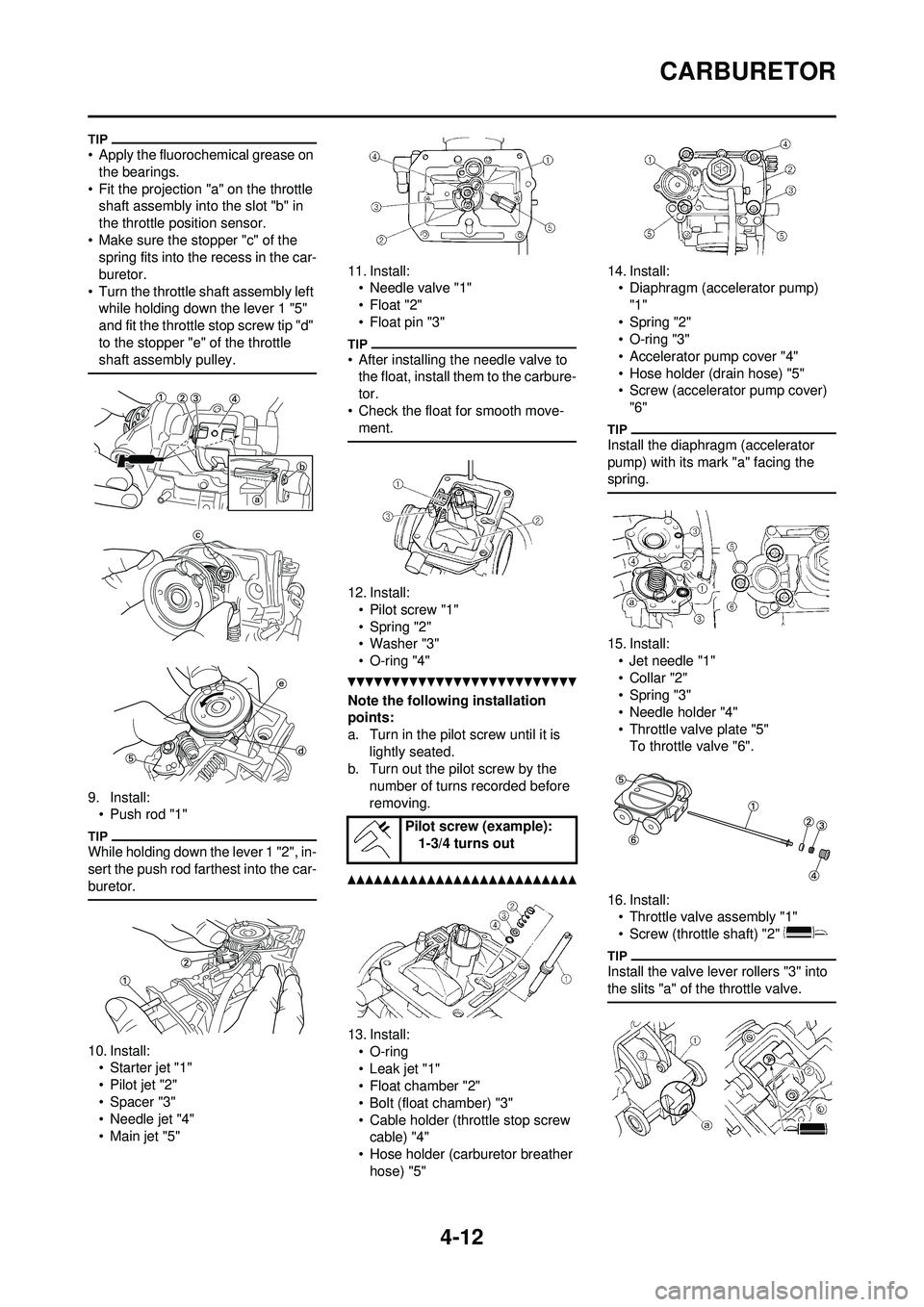
4-12
CARBURETOR
• Apply the fluorochemical grease on the bearings.
• Fit the projection "a" on the throttle shaft assembly into the slot "b" in
the throttle position sensor.
• Make sure the stopper "c" of the spring fits into the recess in the car-
buretor.
• Turn the throttle shaft assembly left while holding down the lever 1 "5"
and fit the throttle stop screw tip "d"
to the stopper "e" of the throttle
shaft assembly pulley.
9. Install:• Push rod "1"
While holding down the lever 1 "2", in-
sert the push rod farthest into the car-
buretor.
10. Install:• Starter jet "1"
• Pilot jet "2"
• Spacer "3"
• Needle jet "4"
•Main jet "5" 11. Install:
• Needle valve "1"
•Float "2"
• Float pin "3"
• After installing the needle valve to the float, install them to the carbure-
tor.
• Check the float for smooth move- ment.
12. Install:• Pilot screw "1"
• Spring "2"
• Washer "3"
• O-ring "4"
Note the following installation
points:
a. Turn in the pilot screw until it is lightly seated.
b. Turn out the pilot screw by the
number of turns recorded before
removing.
13. Install:• O-ring
• Leak jet "1"
• Float chamber "2"
• Bolt (float chamber) "3"
• Cable holder (throttle stop screw cable) "4"
• Hose holder (carburetor breather hose) "5" 14. Install:
• Diaphragm (accelerator pump)
"1"
• Spring "2"
• O-ring "3"
• Accelerator pump cover "4"
• Hose holder (drain hose) "5"
• Screw (accelerator pump cover)
"6"
Install the diaphragm (accelerator
pump) with its mark "a" facing the
spring.
15. Install:• Jet needle "1"
•Collar "2"
• Spring "3"
• Needle holder "4"
• Throttle valve plate "5"To throttle valve "6".
16. Install: • Throttle valve assembly "1"
• Screw (throttle shaft) "2"
Install the valve lever rollers "3" into
the slits "a" of the throttle valve.
Pilot screw (example): 1-3/4 turns out
Page 161 of 196
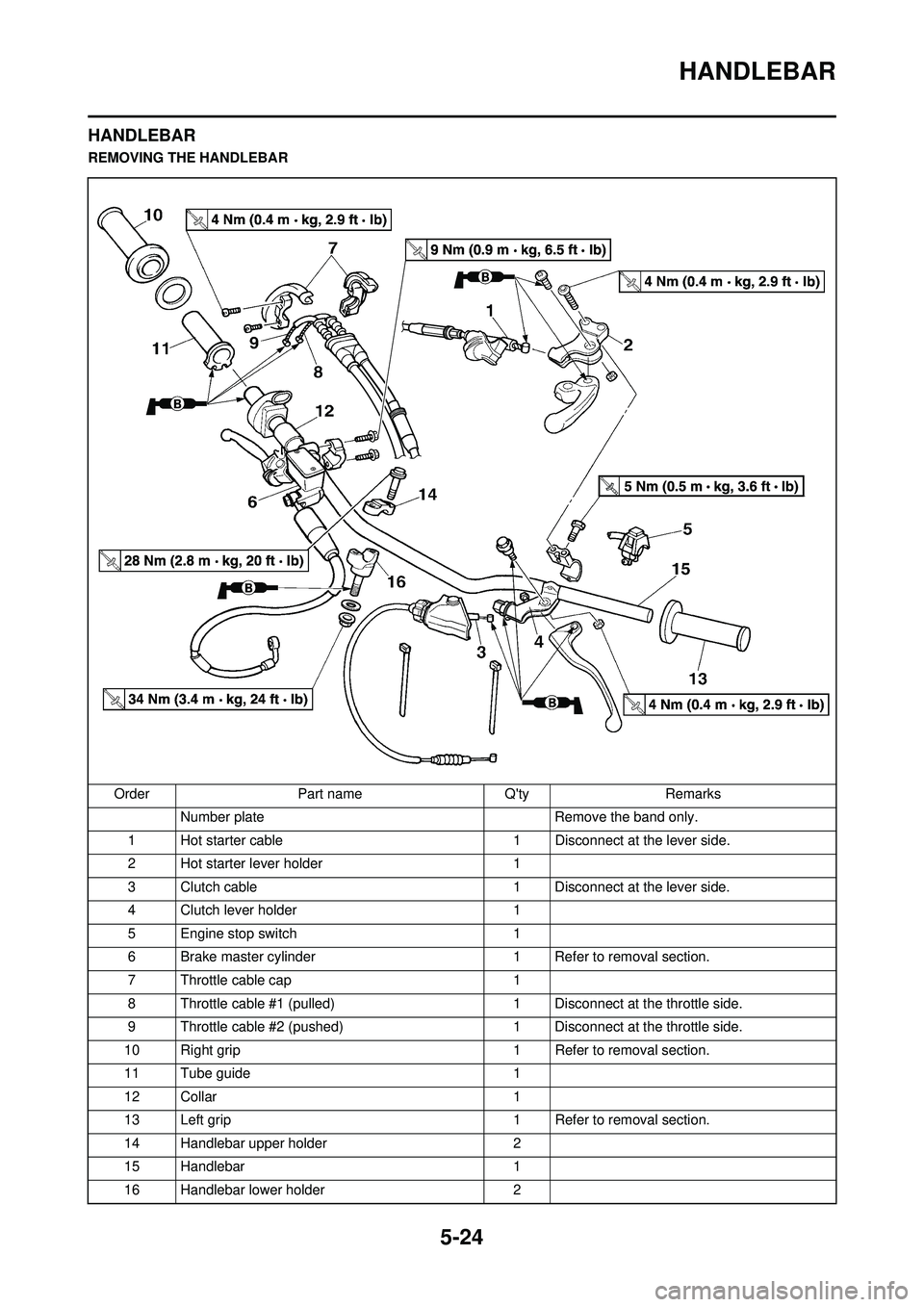
5-24
HANDLEBAR
HANDLEBAR
REMOVING THE HANDLEBAROrder Part name Q'ty Remarks Number plate Remove the band only.
1 Hot starter cable 1 Disconnect at the lever side.
2 Hot starter lever holder 1
3 Clutch cable 1 Disconnect at the lever side.
4 Clutch lever holder 1
5 Engine stop switch 1
6 Brake master cylinder 1 Refer to removal section.
7 Throttle cable cap 1
8 Throttle cable #1 (pulled) 1 Disconnect at the throttle side.
9 Throttle cable #2 (pushed) 1 Disconnect at the throttle side.
10 Right grip 1 Refer to removal section.
11 Tube guide 1
12 Collar 1
13 Left grip 1 Refer to removal section.
14 Handlebar upper holder 2
15 Handlebar 1
16 Handlebar lower holder 2
Page 163 of 196
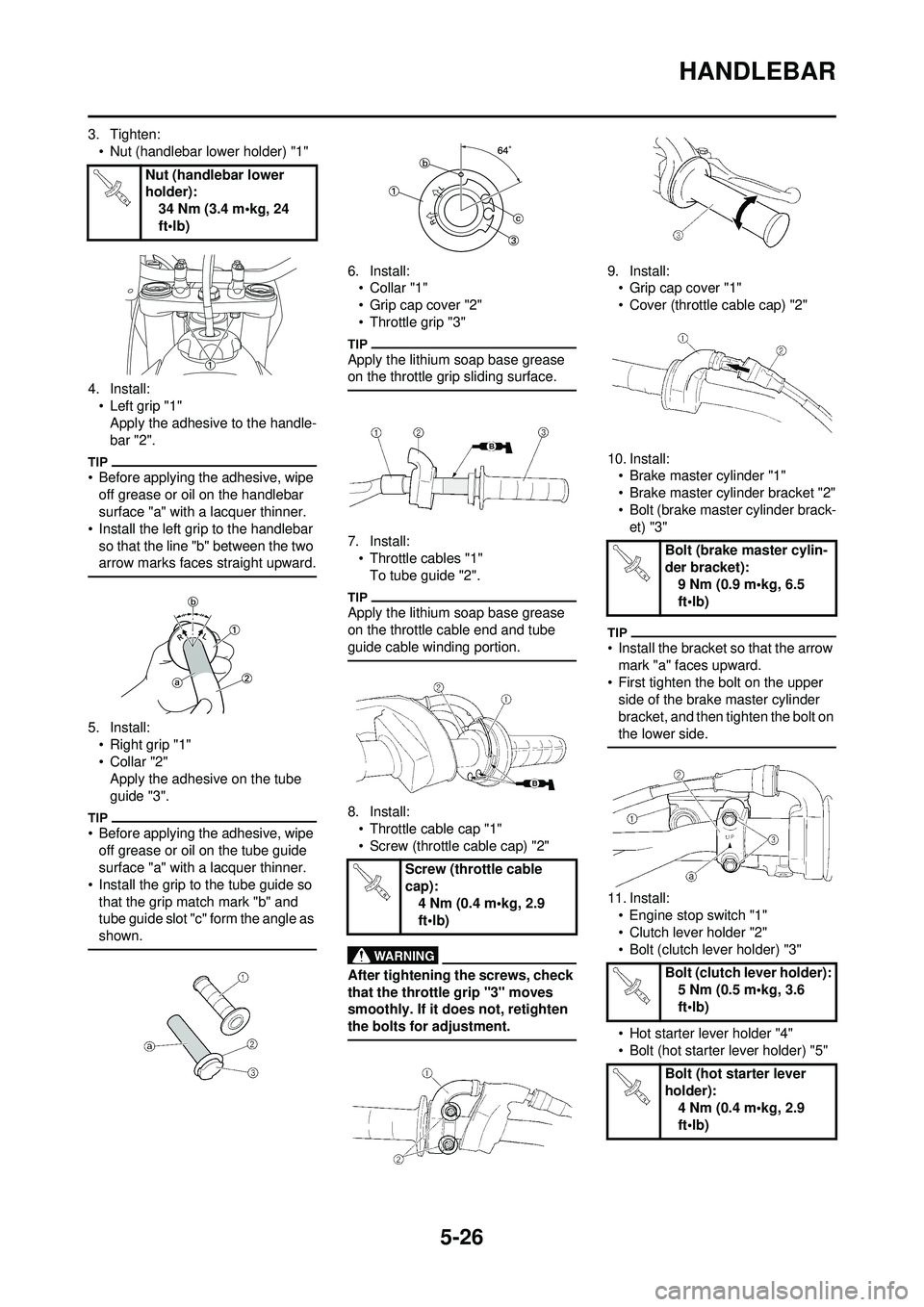
5-26
HANDLEBAR
3. Tighten:• Nut (handlebar lower holder) "1"
4. Install: • Left grip "1"Apply the adhesive to the handle-
bar "2".
• Before applying the adhesive, wipe off grease or oil on the handlebar
surface "a" with a lacquer thinner.
• Install the left grip to the handlebar so that the line "b" between the two
arrow marks faces straight upward.
5. Install:• Right grip "1"
•Collar "2"Apply the adhesive on the tube
guide "3".
• Before applying the adhesive, wipe
off grease or oil on the tube guide
surface "a" with a lacquer thinner.
• Install the grip to the tube guide so
that the grip match mark "b" and
tube guide slot "c" form the angle as
shown.
6. Install:• Collar "1"
• Grip cap cover "2"
• Throttle grip "3"
Apply the lithium soap base grease
on the throttle grip sliding surface.
7. Install:• Throttle cables "1"
To tube guide "2".
Apply the lithium soap base grease
on the throttle cable end and tube
guide cable winding portion.
8. Install:• Throttle cable cap "1"
• Screw (throttle cable cap) "2"
After tightening the screws, check
that the throttle grip "3" moves
smoothly. If it does not, retighten
the bolts for adjustment.
9. Install:• Grip cap cover "1"
• Cover (throttle cable cap) "2"
10. Install: • Brake master cylinder "1"
• Brake master cylinder bracket "2"
• Bolt (brake master cylinder brack-et) "3"
• Install the bracket so that the arrow
mark "a" faces upward.
• First tighten the bolt on the upper side of the brake master cylinder
bracket, and then tighten the bolt on
the lower side.
11. Install:
• Engine stop switch "1"
• Clutch lever holder "2"
• Bolt (clutch lever holder) "3"
• Hot starter lever holder "4"
• Bolt (hot starter lever holder) "5"
Nut (handlebar lower
holder):
34 Nm (3.4 m•kg, 24
ft•lb)
Screw (throttle cable
cap):4 Nm (0.4 m•kg, 2.9
ft•lb)
Bolt (brake master cylin-
der bracket): 9 Nm (0.9 m•kg, 6.5
ft•lb)
Bolt (clutch lever holder): 5 Nm (0.5 m•kg, 3.6
ft•lb)
Bolt (hot starter lever
holder): 4 Nm (0.4 m•kg, 2.9
ft•lb)
Page 164 of 196
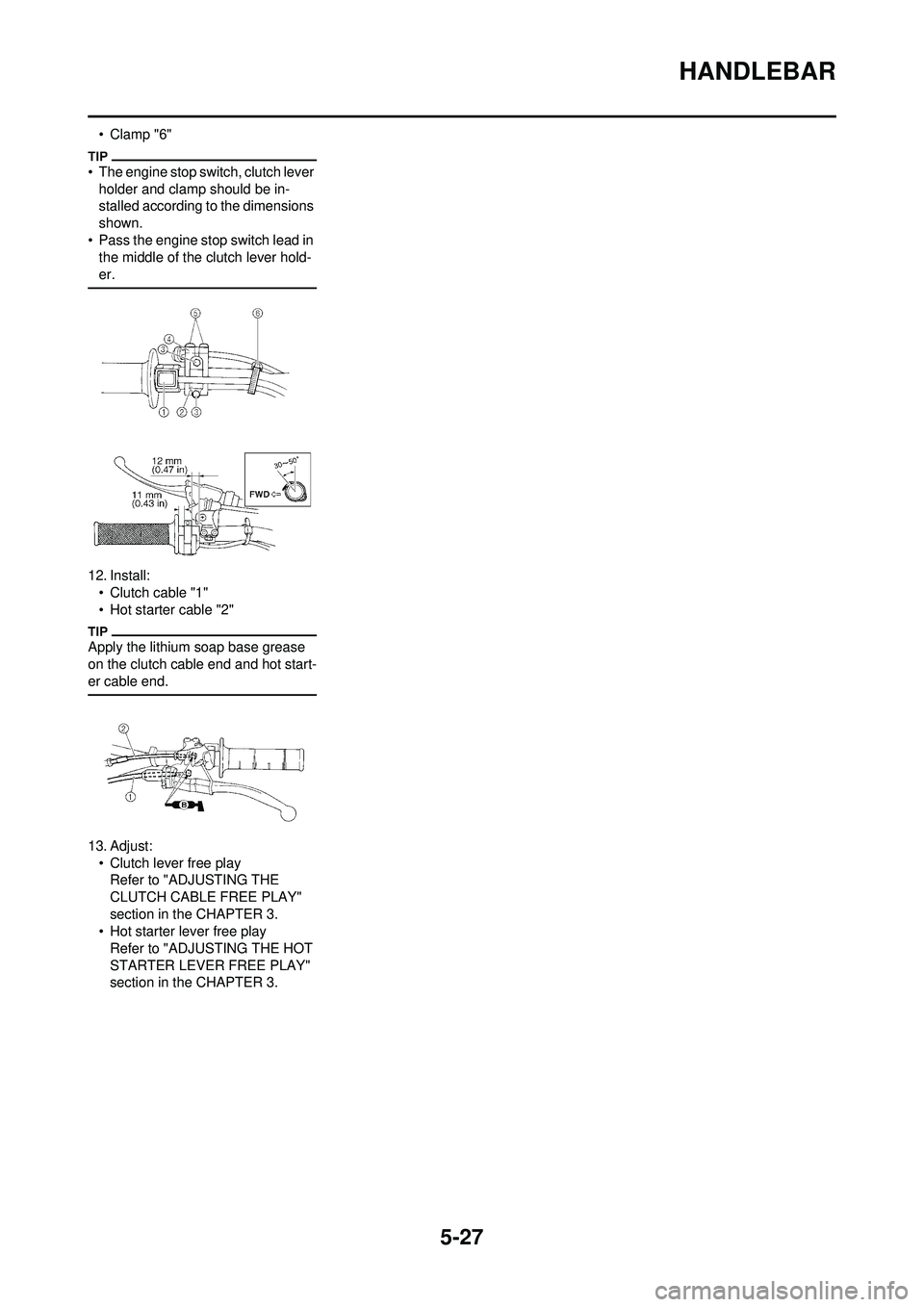
5-27
HANDLEBAR
• Clamp "6"
• The engine stop switch, clutch lever holder and clamp should be in-
stalled according to the dimensions
shown.
• Pass the engine stop switch lead in the middle of the clutch lever hold-
er.
12. Install:• Clutch cable "1"
• Hot starter cable "2"
Apply the lithium soap base grease
on the clutch cable end and hot start-
er cable end.
13. Adjust:
• Clutch lever free playRefer to "ADJUSTING THE
CLUTCH CABLE FREE PLAY"
section in the CHAPTER 3.
• Hot starter lever free play Refer to "ADJUSTING THE HOT
STARTER LEVER FREE PLAY"
section in the CHAPTER 3.
Page 180 of 196
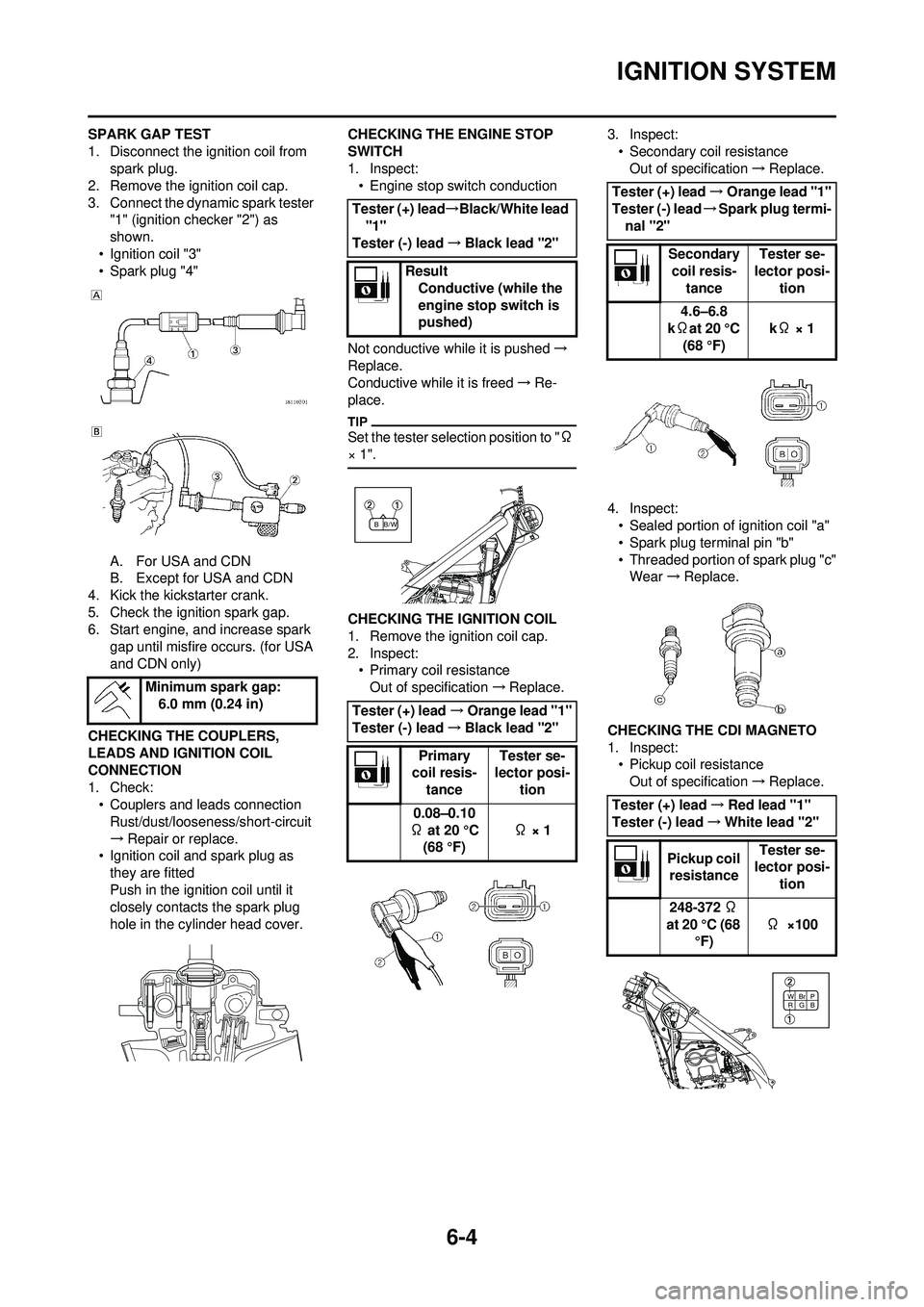
6-4
IGNITION SYSTEM
SPARK GAP TEST
1. Disconnect the ignition coil from spark plug.
2. Remove the ignition coil cap.
3. Connect the dynamic spark tester "1" (ignition ch ecker "2") as
shown.
• Ignition coil "3"
• Spark plug "4"
A. For USA and CDN
B. Except for USA and CDN
4. Kick the kickstarter crank.
5. Check the ignition spark gap.
6. Start engine, and increase spark gap until misfire occurs. (for USA
and CDN only)
CHECKING THE COUPLERS,
LEADS AND IGNITION COIL
CONNECTION
1. Check: • Couplers and leads connection
Rust/dust/looseness/short-circuit
→ Repair or replace.
• Ignition coil and spark plug as
they are fitted
Push in the ignition coil until it
closely contacts the spark plug
hole in the cylinder head cover. CHECKING THE ENGINE STOP
SWITCH
1. Inspect:
• Engine stop switch conduction
Not conductive while it is pushed →
Replace.
Conductive while it is freed →Re-
place.
Set the tester selection position to " Ω
× 1".
CHECKING THE IGNITION COIL
1. Remove the ignition coil cap.
2. Inspect: • Primary coil resistance
Out of specification →Replace. 3. Inspect:
• Secondary coil resistanceOut of specification →Replace.
4. Inspect: • Sealed portion of ignition coil "a"
• Spark plug terminal pin "b"
• Threaded portion of spark plug "c"Wear →Replace.
CHECKING THE CDI MAGNETO
1. Inspect: • Pickup coil resistance
Out of specification →Replace.
Minimum spark gap:
6.0 mm (0.24 in)
Tester (+) lead →Black/White lead
"1"
Tester (-) lead →Black lead "2"
Result Conductive (while the
engine stop switch is
pushed)
Tester (+) lead →Orange lead "1"
Tester (-) lead →Black lead "2"
Primary
coil resis-
tance Tester se-
lector posi-
tion
0.08–0.10
Ω at 20 °C (68 °F) Ω × 1
/W
BB
Tester (+) lead →Orange lead "1"
Tester (-) lead →Spark plug termi-
nal "2"
Secondary coil resis- tance Tester se-
lector posi- tion
4.6–6.8
k Ωat 20 °C
(68 °F) k
Ω × 1
Tester (+) lead →Red lead "1"
Tester (-) lead →White lead "2"
Pickup coil resistance Tester se-
lector posi-
tion
248-372 Ω
at 20 °C (68 °F) Ω
×100
B
WBr
G P
R
Page 184 of 196
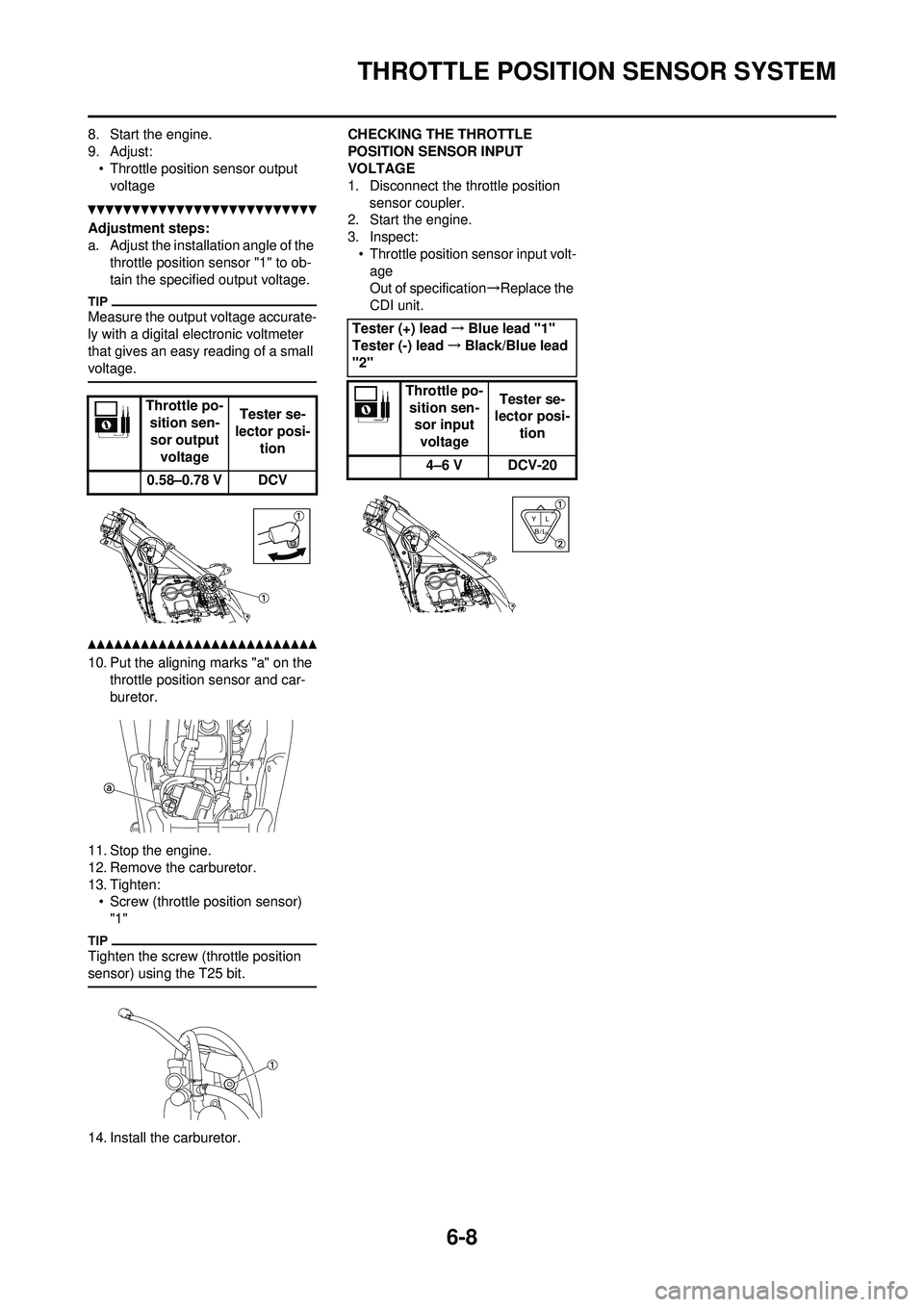
6-8
THROTTLE POSITION SENSOR SYSTEM
8. Start the engine.
9. Adjust:• Throttle position sensor output voltage
Adjustment steps:
a. Adjust the installation angle of the throttle position sensor "1" to ob-
tain the specified output voltage.
Measure the output voltage accurate-
ly with a digital electronic voltmeter
that gives an easy reading of a small
voltage.
10. Put the aligning marks "a" on the throttle position sensor and car-
buretor.
11. Stop the engine.
12. Remove the carburetor.
13. Tighten: • Screw (throttle position sensor) "1"
Tighten the screw (throttle position
sensor) using the T25 bit.
14. Install the carburetor. CHECKING THE THROTTLE
POSITION SENSOR INPUT
VOLTAGE
1. Disconnect the throttle position
sensor coupler.
2. Start the engine.
3. Inspect:
• Throttle position sensor input volt-age
Out of specification →Replace the
CDI unit.
Throttle po- sition sen-
sor output voltage Tester se-
lector posi- tion
0.58–0.78 V DCV
Tester (+) lead →Blue lead "1"
Tester (-) lead →Black/Blue lead
"2"
Throttle po-sition sen- sor input voltage Tester se-
lector posi-
tion
4–6 V DCV-20
LY
B/L
Page 185 of 196
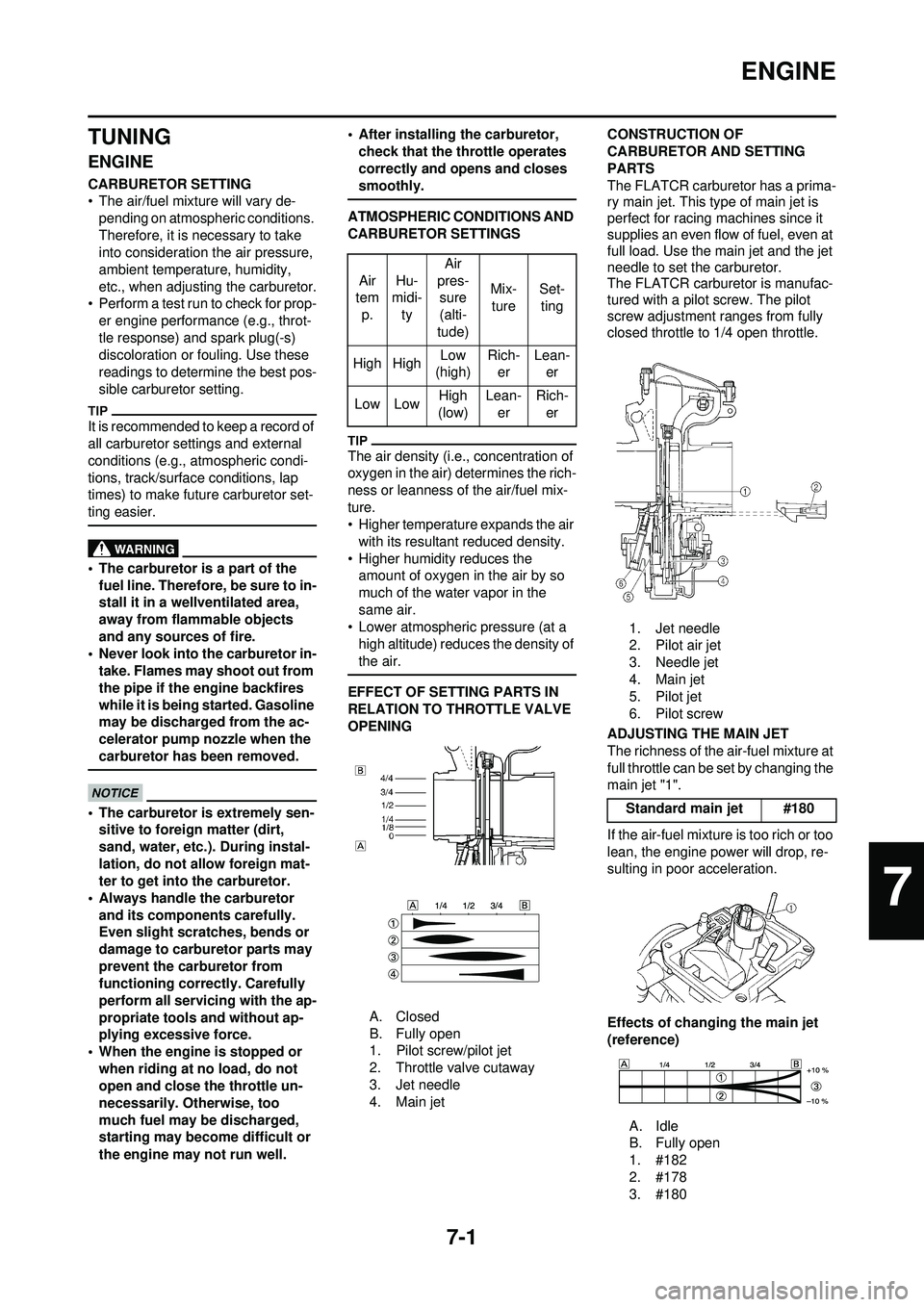
7-1
ENGINE
TUNING
ENGINE
CARBURETOR SETTING
• The air/fuel mixture will vary de-pending on atmospheric conditions.
Therefore, it is necessary to take
into consideration the air pressure,
ambient temperature, humidity,
etc., when adjusting the carburetor.
• Perform a test run to check for prop- er engine performance (e.g., throt-
tle response) and spark plug(-s)
discoloration or fouling. Use these
readings to determine the best pos-
sible carburetor setting.
It is recommended to keep a record of
all carburetor settings and external
conditions (e.g., atmospheric condi-
tions, track/surface conditions, lap
times) to make future carburetor set-
ting easier.
• The carburetor is a part of the fuel line. Therefore, be sure to in-
stall it in a wellventilated area,
away from flammable objects
and any sources of fire.
• Never look into the carburetor in- take. Flames may shoot out from
the pipe if the engine backfires
while it is being started. Gasoline
may be discharged from the ac-
celerator pump nozzle when the
carburetor has been removed.
• The carburetor is extremely sen-sitive to foreign matter (dirt,
sand, water, etc.). During instal-
lation, do not al low foreign mat-
ter to get into the carburetor.
• Always handle the carburetor and its components carefully.
Even slight scratches, bends or
damage to carburetor parts may
prevent the carburetor from
functioning correctly. Carefully
perform all servicing with the ap-
propriate tools and without ap-
plying excessive force.
• When the engine is stopped or when riding at no load, do not
open and close the throttle un-
necessarily. Otherwise, too
much fuel may be discharged,
starting may become difficult or
the engine may not run well. • After installing the carburetor,
check that the throttle operates
correctly and opens and closes
smoothly.
ATMOSPHERIC CONDITIONS AND
CARBURETOR SETTINGS
The air density (i.e., concentration of
oxygen in the air) determines the rich-
ness or leanness of the air/fuel mix-
ture.
• Higher temperature expands the air with its resultant reduced density.
• Higher humidity reduces the amount of oxygen in the air by so
much of the water vapor in the
same air.
• Lower atmospheric pressure (at a
high altitude) reduces the density of
the air.
EFFECT OF SETTING PARTS IN
RELATION TO THROTTLE VALVE
OPENING
A. Closed
B. Fully open
1. Pilot screw/pilot jet
2. Throttle valve cutaway
3. Jet needle
4. Main jet CONSTRUCTION OF
CARBURETOR AND SETTING
PARTS
The FLATCR carburetor has a prima-
ry main jet. This type of main jet is
perfect for racing machines since it
supplies an even flow of fuel, even at
full load. Use the main jet and the jet
needle to set the carburetor.
The FLATCR carburetor is manufac-
tured with a pilot screw. The pilot
screw adjustment ranges from fully
closed throttle to 1/4 open throttle.
1. Jet needle
2. Pilot air jet
3. Needle jet
4. Main jet
5. Pilot jet
6. Pilot screw
ADJUSTING THE MAIN JET
The richness of the air-fuel mixture at
full throttle can be set by changing the
main jet "1".
If the air-fuel mixture is too rich or too
lean, the engine power will drop, re-
sulting in poor acceleration.
Effects of changing the main jet
(reference)
A. Idle
B. Fully open
1. #182
2. #178
3. #180
Air
tem p. Hu-
midi- ty Air
pres- sure
(alti-
tude) Mix-
ture Set-
ting
High High Low
(high) Rich-
er Lean-
er
Low Low High
(low) Lean-
er Rich-
er
Standard main jet #180
7